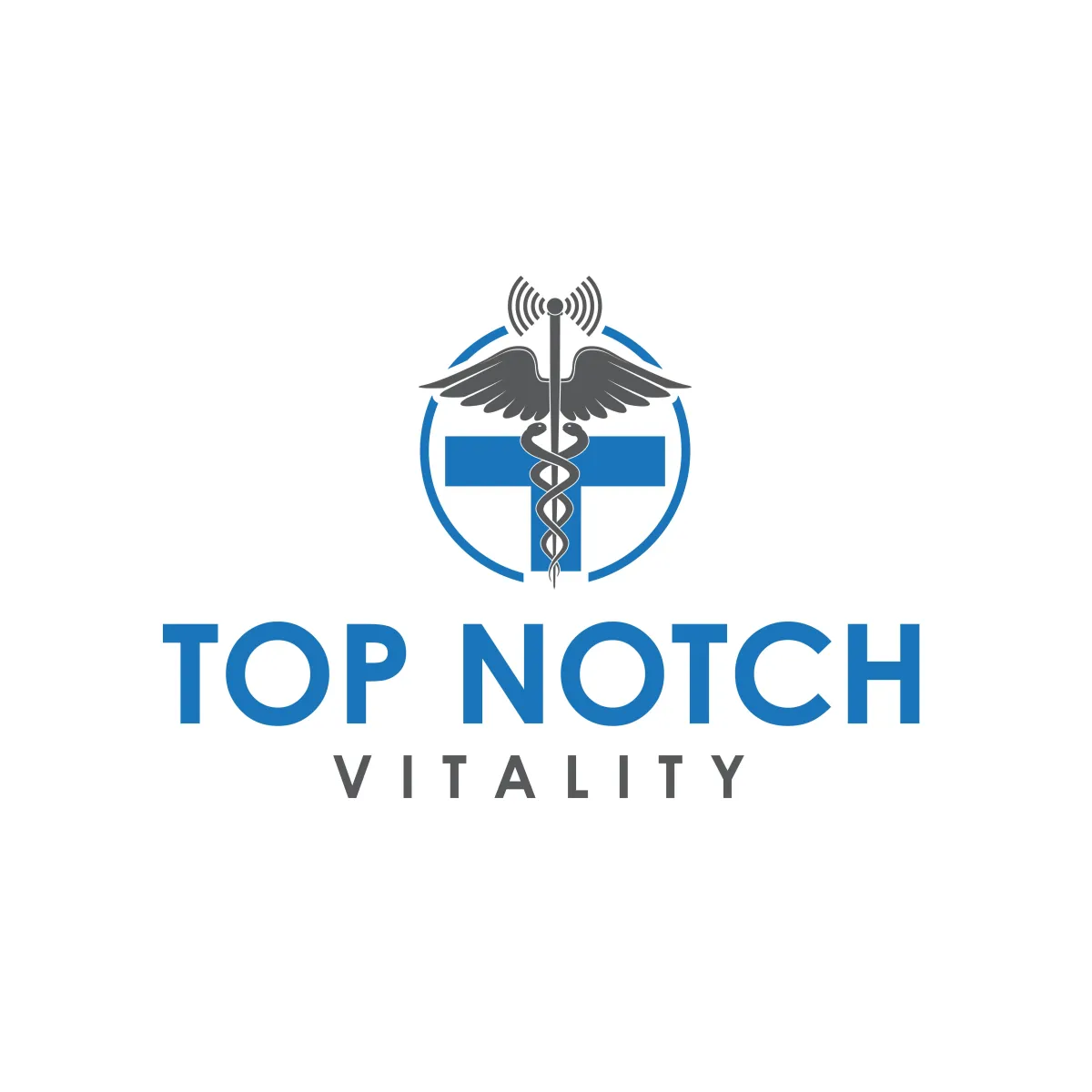The Top Notch Vitality Blog!

"We have made the healthcare process simple, safe, and affordable so that if someone is sick or suffering from an illness they can receive prompt and professional care without delay."
Derek Hazelwood FNP-C

Male Pattern Baldness: From Topical Solutions to Hair Transplants
Androgenic alopecia, commonly known as male or female pattern baldness, is a genetic hair loss condition that affects a large proportion of the population. In men, androgenic alopecia typically begins with hair loss at the temples and crown, while in women, hair thinning usually occurs on the crown and top of the scalp. Androgenic alopecia can have a significant impact on an individual's self-esteem and confidence, making it an issue that should not be ignored.
According to the American Academy of Dermatology, androgenic alopecia affects up to 80 million men and women in the United States alone. This prevalence underscores the need for effective treatment options to help those who are struggling with hair loss. Fortunately, a range of treatments are available to help address androgenic alopecia, from topical solutions to hair transplants.
While there is no cure for androgenic alopecia, seeking treatment can help to slow down or even reverse hair loss. Early intervention is key, as it can be more challenging to restore hair growth once the hair follicles have been destroyed. As such, it is important for those experiencing hair loss to seek professional advice and explore the available treatment options.
In this article, we will discuss the various treatment options for androgenic alopecia, including topical solutions, oral medications, low-level laser therapy, platelet-rich plasma therapy, hair transplants, and combinations of these treatments. Understanding the pros and cons of each treatment option can help individuals make informed decisions about the best course of action for their individual needs.
Topical solutions are often the first line of treatment for androgenic alopecia, and are available over-the-counter or by prescription. The most common topical solution for hair loss is minoxidil, which is available in various strengths and formulations, including foam and liquid. Minoxidil works by increasing blood flow to the hair follicles, thereby promoting hair growth. Another topical solution, finasteride, is only available by prescription and works by blocking the conversion of testosterone into dihydrotestosterone (DHT), a hormone that contributes to hair loss in those with androgenic alopecia.
While topical solutions can be effective in promoting hair growth, they may also come with side effects. Common side effects of minoxidil include:
scalp irritation
dryness
Flaking
Finasteride, on the other hand, can cause sexual dysfunction, decreased libido, and depression in some individuals. As such, it is important for individuals to discuss potential side effects with their healthcare provider before starting treatment with a topical solution.
It is worth noting that topical solutions typically need to be used consistently for several months before any visible results are seen, and the effects are often temporary. Discontinuing use of the topical solution can result in hair loss returning to its previous level. As such, topical solutions may be most effective when used in combination with other treatment options, such as hair transplants.
Oral medications are also an effective treatment for androgenic alopecia. Finasteride and dutasteride are two commonly prescribed medications that can help slow or stop hair loss and promote hair regrowth. These medications work by blocking the production of dihydrotestosterone (DHT), a hormone that contributes to hair loss. Both medications are FDA-approved for the treatment of hair loss in men, but only finasteride is approved for use in women.
Although oral medications can be effective for treating androgenic alopecia, they may also have side effects. For example, finasteride may cause sexual side effects such as erectile dysfunction, decreased libido, and decreased ejaculate volume. Dutasteride may cause similar side effects as well as breast tenderness and enlargement. Patients should talk to their doctor about the potential risks and benefits of these medications before starting treatment.
Other supplements such as biotin, iron, and zinc may also be recommended by healthcare providers for the treatment of androgenic alopecia. These supplements can help support healthy hair growth and prevent further hair loss.
It is important to note that these medications and supplements may take several months to show results, and hair regrowth may be limited. Patients should continue to use these treatments as directed by their healthcare provider and maintain realistic expectations for their hair growth.
Low-level laser therapy (LLLT) is a non-invasive treatment option for androgenic alopecia that involves using low-power lasers or light-emitting diodes (LEDs) to stimulate hair growth. The therapy is believed to work by increasing blood flow to the scalp and promoting the production of cellular energy in hair follicles, which can stimulate hair growth.
There are several types of LLLT devices available, including handheld devices and helmets that can be worn at home. Treatment times can range from a few minutes to up to 30 minutes, several times per week. While some studies have suggested that LLLT may be effective in promoting hair growth and slowing hair loss, the evidence is not yet conclusive and further research is needed to determine its true effectiveness.
Side effects of LLLT are generally mild and include temporary scalp redness and itching. However, some people may experience headaches or dizziness after treatment. LLLT is generally considered safe, but it is important to talk to a healthcare provider before beginning treatment to determine if it is the right option for you.
While LLLT may be a promising option for androgenic alopecia, it is not yet widely accepted as a first-line treatment and further research is needed to determine its effectiveness.
Platelet-rich plasma (PRP) therapy is a relatively new treatment for androgenic alopecia. It involves injecting a concentration of the patient's own platelets into the scalp, which are thought to stimulate hair growth by releasing growth factors. The procedure begins with the extraction of blood from the patient's arm, which is then centrifuged to separate the platelets from the other blood components. The concentrated platelets are then injected into the scalp using a syringe and a fine needle.
Research suggests that PRP therapy may be effective in treating androgenic alopecia, particularly in its early stages. A 2017 study published in the Journal of Cutaneous and Aesthetic Surgery found that PRP therapy improved hair density and thickness in patients with androgenic alopecia, with no significant side effects reported. However, further research is needed to determine the long-term effectiveness of this treatment.
While PRP therapy is generally considered safe, there are some potential side effects, including pain, redness, and swelling at the injection site. In rare cases, infection or bleeding may occur. Patients should discuss the risks and benefits of PRP therapy with their healthcare provider before undergoing the procedure.
PRP therapy offers a promising new treatment option for androgenic alopecia, particularly for those who may not be candidates for other treatments due to allergies or other health concerns. However, more research is needed to determine its long-term effectiveness and safety.
Hair transplants have become an increasingly popular option for those suffering from androgenic alopecia, also known as male or female pattern baldness. This type of hair loss is caused by the hormone dihydrotestosterone (DHT) and affects up to 80% of men and 50% of women over the course of their lifetime. Hair transplant procedures involve moving hair from the back and sides of the scalp, where hair is resistant to DHT, to the balding areas of the scalp.
There are two main types of hair transplant procedures available: follicular unit transplantation (FUT) and follicular unit extraction (FUE). FUT involves removing a strip of hair-bearing skin from the back of the scalp and dissecting it into individual follicular units to be transplanted. FUE, on the other hand, involves removing individual follicular units directly from the scalp using a small punch tool. Both procedures can achieve natural-looking results, but the choice between the two depends on individual factors such as hair density and donor area size.
Hair transplant procedures are generally considered safe and have a high success rate, with most patients achieving a significant improvement in hair density and coverage. However, like any surgical procedure, there are potential risks and side effects such as bleeding, infection, and scarring. It's important to choose a qualified and experienced surgeon and to thoroughly discuss any concerns and expectations before undergoing the procedure.
In addition to the physical benefits of hair transplant procedures, many patients report significant improvements in their self-esteem and overall quality of life. Hair loss can have a profound impact on self-image and confidence, and regaining a full head of hair can be a life-changing experience for many. However, it's important to keep in mind that hair transplant procedures are not a cure for androgenic alopecia and that ongoing maintenance and care are necessary to maintain the results.
Androgenic alopecia can have a significant impact on a person's self-esteem and quality of life. Fortunately, there are many effective treatments available, ranging from topical solutions to hair transplants. It is important to seek professional advice and explore all available options to find the best treatment for each individual's specific needs. Don't let androgenic alopecia hold you back any longer. Take action and seek treatment today. If you're looking for a trusted provider of hair loss treatments, consider Top Notch Vitality. Their team of experienced professionals can help you achieve the full head of hair you deserve.
References:
Gan, D. C., Sinclair, R. D., & Prendergast, M. (2005). Hair transplantation update: procedural techniques, innovations, and applications. Journal of plastic, reconstructive & aesthetic surgery, 58(6), 587-599.
Kim, J. H., Lee, Y. H., & Kim, M. J. (2019). Androgenetic alopecia: An update on pathophysiology and management. Journal of cosmetic dermatology, 18(3), 633-640.
Rossi, A., Cantisani, C., Melis, L., Iorio, A., Scali, E., Calvieri, S., & Carlesimo, M. (2016). Minoxidil use in dermatology, side effects and recent patents. Recent patents on inflammation & allergy drug discovery, 10(1), 57-61.
Get a Consultation with Derek Hazelwood FNP-C TODAY!
Top Notch Vitality strives to eliminate barriers that keep individuals from seeking and/or receiving professional healthcare. Access to healthcare should not only be available to certain individuals, but to all people in need.
Call
(214) 509-8715
Email
support@topnotchvitality.com
Site
www.topnotchvitality.com




